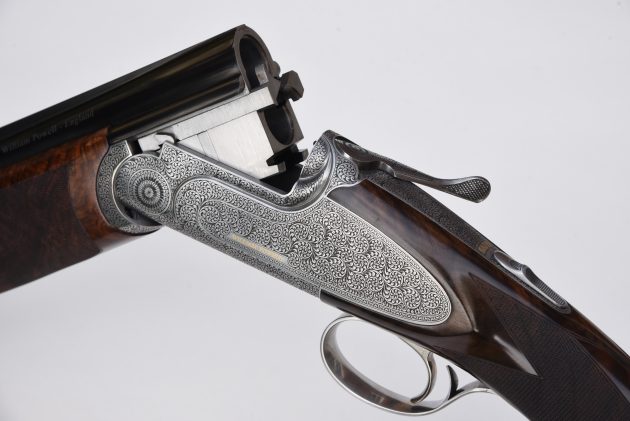Small changes can make a significant difference to a gun’s handling, as this attractive single-trigger over-and-under demonstrates, says Michael Yardley
William Powell Princeps
We have tested the William Powell Princeps previously with less enhanced specification.
The William Powell Princeps 12-bore over-and-under
Weighing just over 8lb, the deluxe single-trigger gun has 30in, 3in-chambered, high-performance steel-proofed barrels with a solid, tapered sighting rib and profusely engraved, colour-case-hardened-effect action. The fore-end iron is extended in Boss style and there is a long trigger-guard with engraved steel cap. It is fixed choke (1/2 and 1/2) with multichokes an option.
First impressions are favourable. This is an attractive model set off with tight scrollwork on its rounded action bar, wellfigured, dark Grade 4 wood and extra finish detailing. The tight scrollwork works well. William Powell notes it is hand cut in its marketing: the result is pleasing and suits the gun’s smooth-shaped action. The maker’s name is neatly inset in gold on the sideplates, the serial number is also set in gold on the long trigger-guard tang (useful if you travel) and there are well-executed rosettes around the hinge points. Double fences are well carved.
Barrels here are monobloc with some unusual features. They carry a solid and tapered top rib and solid side ribs as noted. Ventilated sighting and joining ribs are an option (one that might usefully lower frontal weight). The gun also has Boss-style ‘wings’ – substantial constructions added to the side ribs and that locate the extended fore-end iron and fore-end wood. These are nicely done but add considerable mass forward of the knuckle. Bores are well presented and quite tight at 18.4mm with mid-length forcing cones. They would suit fibre or felt wads well.
Stock
The stock of the William Powell Princeps has an attractive form with a subtly swollen pistol grip of medium size and radius (my preference would be a little longer and deeper). Beautifully proportioned, the rounded fore-end has an Anson rod release rather than a Deeley catch and the stock wood is exceptional, with rich figure in the butt and predominantly straight grain through the grip as always preferred (but not always seen).
Stock was a good length too at 15in but both heel and toe dimensions might have been increased by ⅛in to positive effect. There was not quite enough bump at heel – this protrusion aids in securing and controlling the gun at the shoulder. Another unusual feature on this demonstrator gun was an offset comb. This adds to cast without the need to kick out the heel excessively but it may also lower the head. Although the gun had classic (11/2in and 2in) dimensions for drop, I could lose the bead at elevation with normal cheek pressure.
Different specification
I have shot a similar, slightly lighter gun from William Powell and was much impressed with it. This gun was significantly different in specification and proved what a great difference small changes can make to handling. The extended fore-end iron and wings look good and give the Princeps an upmarket appeal but they change the handling dynamic. There is more inertia that needs to be overcome at the middle front of the gun.
One advantage with the Princeps, however, is that you may specify it exactly as you wish at no greater cost. William Powell tells me gun-buying habits have changed since COVID-19: most customers now buy off the shelf but having a gun made still creates all sorts of interesting possibilities. As Tom Peachey of the company notes: “The options are almost limitless. You could order this gun with double triggers or a selective single trigger. You can upgrade the wood further and specify the grip shape. It is available with 28in, 29in, 30in and 32in barrels in 12-, 20- and 28-bore. The 28-bore may be ordered with a dedicated action or on the 20-bore action.”

William Powell Princeps 12-bore
Technical
This sideplated design is not radical but its development is interesting. The William Powell Princeps and guns similar to it in basic design (trigger-plate over-andunders combining bifurcated lumps and Browning-style bolting with pre-sprung ejectors with vertical trips in the monobloc) are seen in increasing number and ever-better grades of finish. They are offered by several English firms, made in association with Rizzini and other Gardonne houses, and have progressed hugely in 30 years. Most trace origins to cheaper ‘boxlock’ (actually trigger-plate) guns made to a price and competing originally to undercut mid-range models from Beretta and Browning. The guns were decoratively enhanced with sideplates and rounded action bars. They were gradually, if subtly, improved mechanically, and CNC machining and laser engraving improved them further. A fundamentally sound, simple design evolved on the bench and was engineered for mass production. Now, it rivals those guns it was originally built to compete with. It is a well-refined platform to build guns at all grades.
Shooting impressions
Initially I did not shoot this Princeps as well as the previous one tested. The first two birds were missed behind. So, what went wrong? The gun’s weight was a factor, especially the mass added by the extended fore-end iron and barrel wings. They are substantial components. A well-built friend, however, shot the gun extremely well and was full of praise for it. I determined to shoot it again, putting more upper body effort into the swing and taking care not to lose the bead. Results were far better.
What I would order
If I was ordering a William Powell Princeps – and it’s a particularly well-presented gun with a five-year guarantee – I would order the (outstanding) standard version without the extended fore-end and wings and strive for a specification to keep the weight not much over 71/2lb. The gun is worth the effort of getting just right. (Read over-and-under or side-by-side?)





